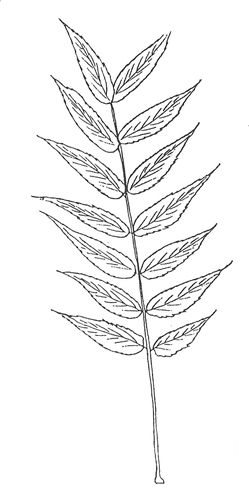Juglans nigra (joo’-glanz ny’-gra)
Family: Juglandaceae, Walnut
Key Steps
- 1b – Alternate leaf arrangement — go to 18
- 18b – Leaf compound — go to 58
- 58b – More than 3 leaflets — go to 59
- 59c – Leaflet margins are medium-serrate — go to 64
- 64a – Chambered pith in older stem growth — Black Walnut
- 59c – Leaflet margins are medium-serrate — go to 64
- 58b – More than 3 leaflets — go to 59
- 18b – Leaf compound — go to 58
Description
 Leaf: Leaflets: 7-23, narrow, irregularly toothed, broadest at base, hairy beneath. May not have end leaflet. Entire leaf is 12-24 inches long. Fragrant when crushed. Hairy, glandular petioles.
Leaf: Leaflets: 7-23, narrow, irregularly toothed, broadest at base, hairy beneath. May not have end leaflet. Entire leaf is 12-24 inches long. Fragrant when crushed. Hairy, glandular petioles.
Bud: Pale brown to whitish, woolly. Terminal bud up to 1/2 inch long. Two pairs of opposite scales on terminal bud. Side buds smaller and paler. Buds may be above each other (superposed).
Leaf Scar: Large, raised, shield-shaped or 3-lobed. Upper edge notched. No hair at tip. Three bundle scars, one in each lobe.
Stem: Stout. Young stems are hairy. Light brown.
Bark: Dark brown to black, furrowed.
Pith: Chambered on older growth. New growth usually doesn’t have chambered pith. Light brown.
Flower: Male: in dropping catkins on last year’s wood. Female: at end of current wood, short spikes of one to four flowers. Both male and female on same tree. Yellowish-green.
Fruit: Furrowed nut in thick, round husk. Green to black.
Habit: Large shade tree. Round, open canopy. 40+ feet tall. Strong central leader.
Culture: Moist, well-drained soils. Full sun. Allelopathic (may be hard to grow some plants near walnut trees).
Resources




